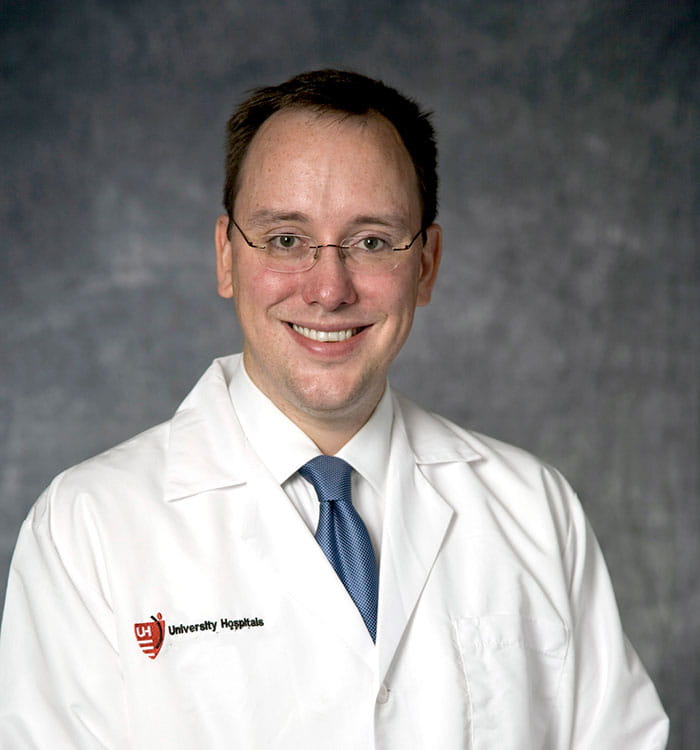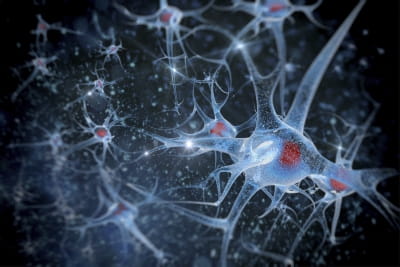The Leading Edge Of Neuromodulation
January 04, 2016
The Functional and Restorative Neurosurgery Center drives innovative neuromodulation techniques and devices forward
UH Neurological Institute online article - January 2016
 Jonathan Miller, MD
Jonathan Miller, MDSince the early days of exploring neuromodulation techniques as treatment for a handful of neurological disorders, neurosurgeons within University Hospitals Neurological Institute at UH Case Medical Center have advanced the field, applying approaches such as deep brain stimulation (DBS) to tackle challenging disorders, many of which were categorized as untreatable.
In 2013, the UH Neurological Institute launched the Functional and Restorative Neurosurgery Center, directed by Jonathan Miller, MD, George R. and Constance P. Lincoln Master Clinician, Director of the Functional and Restorative Neurosurgery Center at UH Case Medical Center and Associate Professor and Vice Chair for Educational Affairs in the Department of Neurosurgery at Case Western Reserve University School of Medicine, with the goal of advancing even greater innovations in neuromodulation treatments and techniques. Today, two main foci for the program are the development of intracortical brain-computer interfaces for patients with tetraplegia, and application of deep brain stimulation (DBS) and spinal cord stimulation for a wide variety of neurological and neurobehavioral disorders.
“As we research and refine novel techniques in brain and nerve stimulation, we may find that we have the ability to improve or cure any disorder of the brain caused by malfunctioning circuits,” says Dr. Miller.
Pioneering the BrainGate2 Neural Interface System
UH Case Medical Center serves as a clinical site for the national pilot study of the BrainGate2 Neural Interface System. The study, which seeks to demonstrate the safety and feasibility of a novel system that allows patients with tetraplegia, often also called quadriplegia, to control a computer cursor, assistive device or communication software, simply by imagining movement of a hand. The research is administered by Massachusetts General Hospital in Boston and conducted in several medical centers around the United States, with funding from the National Institutes of Health (the NIH Eunice Kennedy Shriver National Institute of Child Health and Human Development/National Center for Medical Rehabilitation Research), and from the Department of Veterans Affairs Rehabilitation Research and Development Service.
 This groundbreaking research project uses a baby-aspirin-sized electrode placed in the brain to collect, process and decipher electrical signals produced by neurons that control body movement. The interface interprets the signals and may enable severely disabled individuals—including those with traumatic spinal cord injury and loss of limbs—to communicate and control functions through thought alone.
This groundbreaking research project uses a baby-aspirin-sized electrode placed in the brain to collect, process and decipher electrical signals produced by neurons that control body movement. The interface interprets the signals and may enable severely disabled individuals—including those with traumatic spinal cord injury and loss of limbs—to communicate and control functions through thought alone.
Dr. Miller, who is the author of more than 70 articles and editorials in peer-reviewed journals in these topics, along with Benjamin Walter, MD, Director of the Movement Disorders Center, Medical Director of the Deep Brain Stimulation Program, Penni and Stephen Weinberg Master Clinician at University Hospitals, and Assistant Professor of Neurology, Case Western Reserve University School of Medicine, and Bob Kirsch, PhD, Professor of Biomedical Engineering, Case Western Reserve University, lead this work at UH Case Medical Center. If successful, they plan to investigate whether this unique intracortical brain-computer interface could eventually be adapted to help patients regain control over paralyzed limbs.
Advancing Applications of Deep Brain Stimulation
The Functional and Restorative Neurosurgery Center at UH Neurological Institute also continues to build on the institution’s reputation as a leader in the application of deep brain stimulation and other spinal and nerve stimulation techniques to treat movement and neurobehavioral disorders.
Jennifer Sweet, MD, Neurosurgeon, Division of Functional and Stereotactic Neurosurgery at UH Case Medical Center and Assistant Professor of Neurosurgery, Case Western Reserve University School of Medicine, leads a multi-disciplinary project to apply tractography, or three-dimensional modeling of neural pathways based on diffusion tensor imaging, to map the connection networks in the brains of patients with treatment-resistant bipolar disorder, and therefore identify the underlying mechanism for the disease. The study is funded by the NIH (National Center for Advancing Translational Sciences). Dr. Sweet is the author of more than 20 peer-reviewed research articles, editorials and invited reviews on topics related to neuromodulation, including as lead author on a September 2015 study published in Neurosurgery about Occipital Nerve Stimulation.
The team hypothesizes that bipolar disorder is caused by abnormal connections within particular brain regions. If accurate, the study will surgically implant electrodes into these regions and attempt to produce mood stabilization by normalizing the connections via deep brain stimulation.
UH Case Medical Center neurosurgeons are also leading active research on new DBS applications for dystonia (involuntary muscle contractions) and Parkinson’s disease, including NIH-funded research investigating the mechanisms of how DBS provides therapeutic benefit in dystonia.
These efforts in brain and nerve stimulation techniques are just the latest examples of the UH Neurological Institute’s long term strength of expertise in these areas, starting with the work of Raymond Onders, MD, Margaret and Walter Remen Chair in Surgical Innovation and Professor of Surgery at Case Western Reserve University School of Medicine, who first applied phrenic nerve stimulation for diaphragm pacing to help patients with spinal cord injuries and ALS breathe.
In recent years, the UH Neurological Institute has continued to push the envelope in these approaches, including leading the first studies of DBS as treatment for Tourette syndrome and application of DBS in the fornix region of the brain for epilepsy. The Functional and Restorative Neurosurgery Center plans to apply these and more such leading-edge technologies to successfully treat additional neurological and neurobehavioral challenges in the near future.
Visit UHHospitals.org/neuro or call 1-866-UH4-CARE (1-866-844-2273) or 216-844-2724 to refer a patient or learn more.
Tags:


